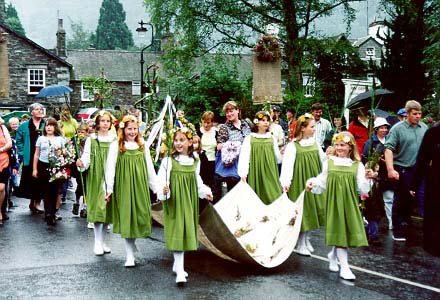With dictionary look up - Double click on any word for its definition.
This section is in advanced English and is only intended to be a guide, not to be taken too seriously!
In the Middle Ages, nobody had carpets - they used rushes as a floor-covering instead. Many places held a special summer ceremony when the rushes were harvested. In some villages, they made special rush sculptures, called bearings, and carried these in a procession. Rushbearings are still popular in Cumbria and other parts of north-west England.
Some villages use a rushcart, and each village tries to outdo the other by building a bigger or more elaborate structure with the front covered by a sheet decorated with tinsel and artificial flowers and hung with polished copper, brass and silver household items.
One of the most famous Rushbearing Ceremonies is held in Grasmere every year. It features a procession through the village where rushes are carried on a special linen sheet, held by six girls (the Rush Maidens), dressed in green, while others are made into elaborate shapes (called rush-bearings). There is also a brass band, church choir, and anyone else who wishes to can join in by carrying their own decorated rushes.

